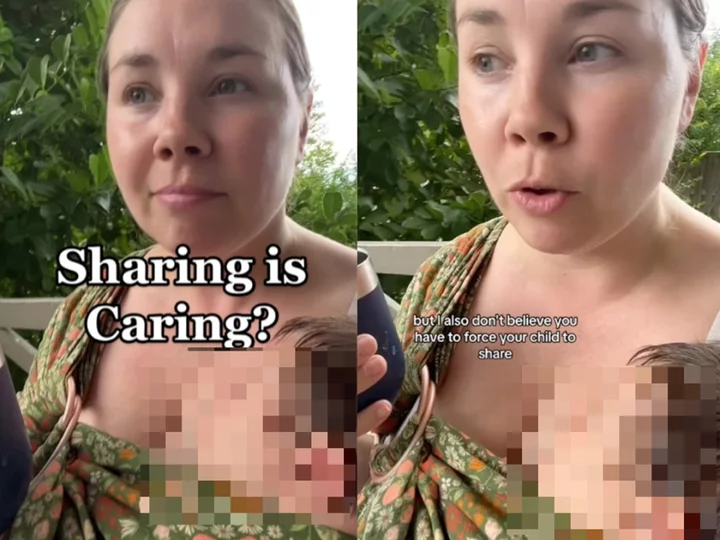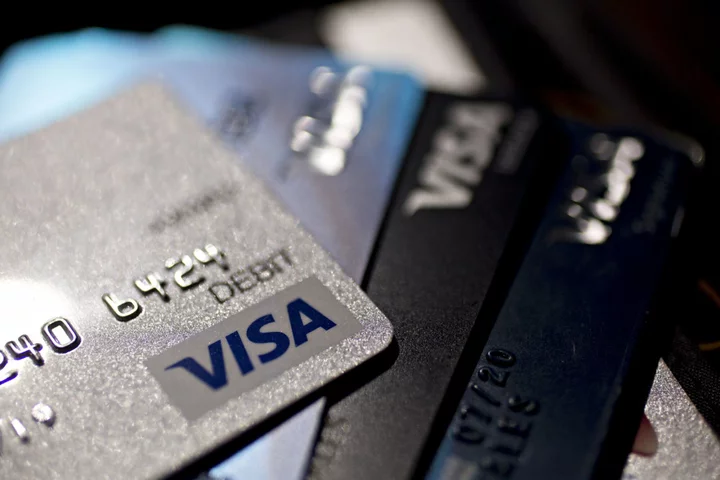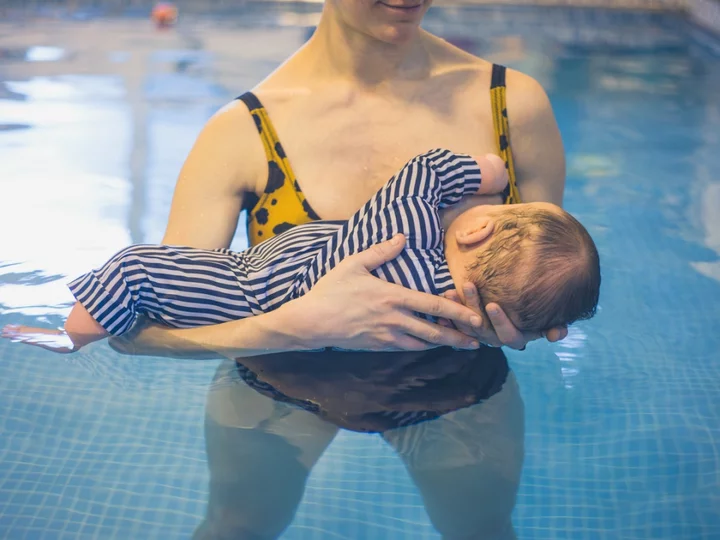
Mother asks if children should be ‘forced to share’ after son is ‘pushed’ for not sharing on splash pad
A mother has questioned whether children should be “forced” to share after revealing an incident in which her son was allegedly “pushed” by another child on a splash pad for not sharing. Skye Amundsen, a mother from Maryland who goes by the username @hopeandplum on TikTok, reflected on the incident in a video posted earlier this month. According to Amundsen, who noted that the video was a “message to the mom that had the audacity to tell me that my son should have to share at the splash pad,” she and her two-year-old son had been playing at a local park with an outdoor sprinkler when the confrontation occurred. “Now, hear me out before you judge me. My son is two. He’s playing. He likes to step on the little things on the splash pad and stop them from splashing up,” the TikToker said. “This splash pad has tons of these, so he’s not hurting anyone.” In the video, the TikToker said that a little girl, who was “unhappy” with her son’s behaviour, then walked up to the two year old and “pushes him”. “She’s bigger than him and she pushes him. And my son’s like: ‘No’ and he steps back on it,” Amundsen recalled. “And she pushes him again.” According to Amundsen, she was “sitting there watching” and “waiting” for the mother of the other child to intervene. “I was like, well, you know, I’m going to give her a chance,” the TikToker said. @hopeandplum What do you think? We don’t force sharing and find our kids do it naturally most of the time. But why would anyone share with someone being mean? #newmomtips #summermom #momlife ♬ original sound - hope&plum | Baby Carriers Amundsen said that the other mother didn’t intervene despite the woman’s daughter allegedly pushing her two year old for a third time. However, after the third time, the TikToker said her son got “mad” and pushed the other child back. “So I intervene, because I’m his mother and I’m not going to let him push people,” Amundsen continued, adding that, as she was talking to her son, the other mother approached her to confront her about her son’s behaviour. “As I’m talking to my son, this woman has the audacity to say to me: ‘You should really teach your son to learn how to share, it would be better for him,’” the TikToker said. “I’m sorry, my son should learn how to share? Your daughter walked up and shoved my son three times, so my child should allow your child to push him and that’s acceptable and he should share with that human?” In the video, Amundsen then acknowledged that “everyone has different opinions on sharing,” and that she “likes” sharing and “thinks it’s nice,” but also doesn’t believe “you have to force your child to share, especially when another child is getting physical with them”. According to Amundsen, she ultimately told the other mother that they could “agree to disagree” when it came to their respective opinions about sharing. As of 25 July, the TikToker’s video, which she captioned: “What do you think? We don’t force sharing and find our kids do it naturally most of the time. But why would anyone share with someone being mean?” has been viewed more than 609,000 times, prompting other parents to weigh in in the comments. In response, the majority of viewers said they agreed with Amundsen on the basis that sharing shouldn’t be expected after “pushing”. “I totally agree with you. Definitely not sharing after pushing. Oh heck no,” one person wrote. Another said: “Absolutely agree. Also what is he supposed to share? I don’t understand, she wants him to let her use the single water spout that he was playing with?” “Wowww, the nerve of that other mom. In all fairness, you have better control than me,” someone else wrote, prompting Amundsen to reveal that she was “too stunned to speak” during the confrontation. In response to another comment, she said she was in “true shock” but that she was later “kicking” herself for “not saying more”. The Independent has contacted Amundsen for comment. Read More Woman claims restaurant ‘hack’ for toddlers solves family dinners out Woman praised for refusing to switch first class seat on plane with child Mom sparks backlash for piercing newborn’s ears in hospital: ‘How is that even legal?’ Schoolboy almost dies from swallowing magnets for TikTok challenge Woman shares honest review of New York City apartment TikTok mom slammed after making 5-year-old son run in 104 degree heat
2023-07-26 05:57

Abortion rights amendment qualifies for November ballot in Ohio
Ohio Secretary of State Frank LaRose announced Tuesday that organizers submitted enough valid signatures to put an amendment on the November ballot to enshrine abortion rights in the state's constitution.
2023-07-26 05:49

Visa Card Spending Tops Estimates as Travel Demand Stays Strong
Visa Inc. reported card-spending growth that was more robust than Wall Street expected as consumer demand for travel
2023-07-26 04:51

Walmart Dangles Cash Back on Travel as New Membership Perk
Walmart Inc. is adding cash-back travel rewards to its membership plan as the company pushes to gain ground
2023-07-26 04:48

Delta's New JFK SkyClub Is Designed to Avoid Overcrowding. Here’s a Look Inside.
In a bid to ease overcrowding and meet elevated demand, Delta Airlines Inc. on July 25 opened its
2023-07-26 04:23

LVMH’s US Weakness Weighs on Sales as China Rebounds
LVMH’s US sales declined in the second quarter as a sluggish economy deterred some shoppers from buying its
2023-07-26 02:48

What is cardiac arrest? The condition that sent LeBron James’ son Bronny to the hospital
LeBron James’ son Bronny suffered cardiac arrest during his University of Southern California basketball practice and was rushed to the hospital, according to a statement released by the family’s spokesperson on Tuesday. The public statement confirmed Bronny was out of the ICU, stabilised, and in recovery. Cardiac arrest is “the sudden loss of all heart activity due to an irregular heart rhythm,” and is also referred to as sudden cardiac arrest or sudden cardiac death, according to the Mayo Clinic. Cardiac arrest refers to when the heart stops completely, and the body no longer has blood or oxygen flow. If not treated immediately, the condition can lead to death. The National Institute of Health attributes the cause of cardiac arrest to types of arrhythmias, irregular heartbeats that stop the blood from pumping through to the heart, with the main causes “ventricular fibrillation or ventricular tachycardia,” both types of arrhtyhmias. If a person has had prior cardiac arrest, heart valve disease, arrhtyhmias caused by gene defects, congenital heart defects, or coronary heart disease, they are more at risk. Family history, smoking, obesity, diabetes, high cholesterol, and high blood pressure, can put an individual at risk too. A heart attack differs from sudden cardiac arrest, as a heart attack means blood flow to a specific part of the heart is blocked which has the potential to change the “heart’s electrical activity that leads to sudden cardiac arrest,” while sudden cardiac arrest isn’t a blockage, the Mayo Clinic notes. According to the NIH, sudden cardiac arrest typically causes the individual to become unconscious and stops their breathing. Other symptoms include sudden collapse, no response to shouting or shaking, and no pulse. In certain cases, people may exhibit chest discomfort, weakness, shortness of breath, and heart palpitations before they suffer from cardiac arrest. Usually, the condition transpires without warning. According to M Health Fairview, a person who has a heart attack could be able to recognise their condition and be able to call emergency medical services. However, people undergoing cardiac arrest are typically unable to identify it in time. “Cardiac arrests are much rarer than heart attacks, but they are much deadlier. There are half as many – roughly 400,000 – reported each year in the US,” the report stated, adding that these instances are often fatal if not treated immediately. The NIH said: “Cardiac arrests usually occur in people’s homes, where no healthcare provider is present to make a diagnosis.” When first responders reach the patient, they will use an electrocardiogram, a heart imaging test, which will display ventricular arrythmia. Additionally, the NIH stated: “Most often, cardiac arrest is diagnosed after it occurs. Healthcare providers do this by ruling out other causes of a person’s collapse.” Treatments for cardiac arrest include cardiopulmonary resuscitation and the use of an automated external defibrillator (AED). CPR is often necessary, as well as resetting the person’s heart rhythm with an AED. Certain medications, including beta blockers, calcium channel blockers, and Angiotensin-converting enzyme (ACE) inhibitors, and surgeries can help treat the condition too, according to the Mayo Clinic, while surgical operations to aid cardiac arrest include “implantable cardioverter-defibrillator, coronary angioplasty, coronary artery bypass surgery, radiofrequency catheter ablation, and corrective heart surgery”. To prevent sudden cardiac arrest, the Mayo Clinic recommends establishing a healthy diet, going to the doctor regularly, avoiding tobacco use or smoking, heart disease screenings, and blood pressure and cholesterol monitoring. Furthermore, the clinic suggests being well-versed in CPR if you live with someone who may be at risk of the condition. A Johns Hopkins Medicine report acknowledges the benefits of exercising regularly in avoiding cardiac arrest. “A number of studies have also shown that people who exercise regularly are less likely to suffer a sudden heart attack or other life-threatening cardiac event,” the organisation noted. Read More What is Bell’s palsy? The neurological disorder Tiffany Chen was diagnosed with after giving birth Elon Musk slammed for pushing anti-vax conspiracy in response to LeBron James’ son Bronny suffering cardiac arrest LeBron James’ son Bronny suffers cardiac arrest at basketball workout Mom left ‘appalled’ after water park says she can’t breastfeed son in lazy river Scientists share the 8 habits that could take 20 years off your life Everything you need to know about using a defibrillator
2023-07-26 01:46

Breastfeeding mother left ‘upset and appalled’ after water park told her to stop nursing son in lazy river
A mother says she was left humiliated after water park staff told her she wasn’t allowed to breastfeed her nursing son in the lazy river. Tiffany Francis, a mother of two, from Georgia, took to Facebook on 14 July to detail the incident that allegedly occurred at Rigby’s Water World in Warner Robins, Georgia. Her Facebook post has since gone viral, with more than 1,000 likes and comments. “I have never in my years of being a breastfeeding mother had one single negative comment made to me about breastfeeding while out in public. I’ve had supportive comments from random people, but today was a different day,” she began her post. The mother then explained that she’d brought her 11-month-old son to the water park’s lazy river so she could nurse him before his nap. “He likes motion to sleep, he sleeps well in the car or swing, so he will also sleep in the lazy river,” she wrote. After her son was latched, Francis recalled that a lifeguard informed her that she wasn’t allowed to breastfeed in the lazy river. At first, she laughed off the lifeguard’s request because she thought it was a joke. Then, his boss came over to Franics and reiterated the lazy river’s rules against breastfeeding. “I asked her if it was posted somewhere and she told me that it was posted in the rules out front,” Francis said. “So I got out of the lazy river, and I went to read the rules.” The mother of two soon discovered that there was no rule against breastfeeding posted outside the lazy river attraction, and asked to speak to the water park’s manager. However, the manager instead claimed it was a “courtesy to other people” that she wasn’t allowed to breastfeed and cited the park’s rules against food or drink in the lazy river. According to the woman, she then asked for her family’s season passes to be refunded. “I can’t go there if I can’t get my son to nap while I’m there,” Francis said, noting that the water park staff wouldn’t refund her season pass. “Imagine all the bodily fluids being excreted into the water, but they’re worried about breastmilk when the baby was latched, my breast was out of the water, and the milk was only going into [the] baby’s mouth,” she continued. “I left crying, because I was told I couldn’t feed my child, which by the way it is against the law to tell a mother they can’t breastfeed their child. But sure, let’s worry about offending people by feeding a child.” Francis also pointed out how she witnessed several children sleeping in their mothers’ laps in the lazy river, and other children with their heads resting on their moms’ chests. “My situation looked just like theirs, my breast wasn’t exposed. My son’s face was covering everything,” she said. “Without looking extra hard, you’d think he was just asleep on my chest. But somehow I made people uncomfortable by doing the most natural thing I could do for my child, while just trying to let him nap.” Francis continued: “I’m just so upset and appalled and wanted to give a heads up to all the other moms out there that this is how breastfeeding moms are treated at Rigby’s Water World. You’re also not allowed to bring snacks in for the baby, so I was told today. I guess they’d rather babies just go hungry.” According to Georgia state law, which states that the “breastfeeding of a baby is an important and basic act of nurture,” a mother is allowed to “breastfeed her baby in any location where the mother and baby are otherwise authorised to be”. Speaking to People, Tiffany Francis described the incident as “humiliating” and noted that other breastfeeding mothers have since come forward sharing similar explanations about being shamed in public. "I just really didn’t think anybody would care. You’re at a water park. People are already pretty naked there, right? I don’t think it was the most offensive thing to happen that day," she told the outlet. “As a mom, it’s just crazy that people think it’s not okay to feed your own child. If it’s a bottle, it’s fine. Feeding them table foods, sure. But feeding them from the breast just grosses people out for some reason,” she added. “It’s been sexualised to the point where it’s not a natural thing, and that’s just gross.” In one comment, a fellow mother wrote: “Girl! Call me any day I’m off and we will go. I saw a mom nursing the other day and kept an eye on her just in case anyone approached. Wish I was still nursing because I would nurse right next to you!!” “What?! Sounds like a good old nursing mama sit-in needs to happen,” another commented. “How is that even still a ‘thing’ in 2023.” Meanwhile, one dad said: “Wow, as a father this is unbelievably wrong. Anyone should be able to feed their kid anywhere without a problem.” A member of the Rigby family, the owners of Rigby’s Water World, responded to the Facebook post in the comments section: “I know that breastfeeding is allowed in the park and I can understand the safety issues that come in hand with feeding in moving water. As for the courtesy of other guests, I agree that a mom should be able to breastfeed at any time, however an exposed breast in a water feature without a covering could be seen as indecent (we wouldn’t let another guest do the same).” She noted that the water park does have shaded seating, family rooms, and an “admin building” designated for breastfeeding. According to Today, Rigby’s Water World revised its breastfeeding policy within hours of the incident and apologised to Francis for the “misguided” policy. “We had a policy in place that didn’t allow breastfeeding in the river that was in line with the health department’s standard on no eating or drinking in the pools,” said Steve Brown, vice president of operations at Rigby’s Water World. “When I was made aware of the law that mothers can breastfeed anywhere they’re allowed to be, we reviewed our policy, reaching out to other experts who operate aquatic facilities,” he says. “From there, we decided to allow our guests to breastfeed in the pools, should they choose.” Georgia’s Department of Public Health rules and regulations for public swimming pools, spas, and recreational water parks states that “bathers shall not be allowed to eat or drink while in or partially in the water”. “We were under the impression it was a health code violation,” Brown told the outlet. “It was a misunderstanding…it was my mistake to misinterpret the law…there are different opinions on this issue but we want to comply with the law.” Brown added that Rigby’s did not issue Francis a refund for her season pass, and maintained that she was not asked to leave the park. The Independent has contacted Tiffany Francis and Rigby’s Water World for comment. Read More Researchers warn after 25 types of toxic flame retardant found in human breast milk: ‘Disturbing’ Keke Palmer’s boyfriend isn’t the only one who needs to stop telling women how to dress Woman sparks debate with claim she’s discovered the best month to get pregnant Woman claims restaurant ‘hack’ for toddlers solves family dinners out Mother calls out ‘double standard’ after husband is praised for doing ‘bare minimum’ Husband exposed for reaction to learning his wife is pregnant again
2023-07-26 01:29

For migrants, the Darien Gap is hell; for adventure tourists, it's a magnet
By Laura Gottesdiener and Daina Beth Solomon MEXICO CITY Deep in the Panamanian jungle, Venezuelan migrant Franca Ramirez
2023-07-26 00:55

The world's biggest ice cream company says heat waves may not help sales
Can it ever be too hot for ice cream? According to Unilever, yes.
2023-07-25 22:27

Grain Prices Could Rise Up to 15% From Black Sea Deal Pause, IMF Says
Global grain prices could increase as much as 15% after Russia pulled out of a deal that allowed
2023-07-25 22:25

Everything you need to know about using a defibrillator
In a huge step for first aid in the UK, more than 20,000 defibrillators – which are devices that give an electric shock to the heart of a person who is in cardiac arrest – have been delivered to state schools across the country since January. Cardiac arrest can affect anyone, of any age, but according to St John Ambulance research, when a defibrillator is used within the first three minutes of a cardiac arrest, the chances of survival increase by up to 70%. Knowing how a defibrillator works could save someone’s life, but what should you know before using one? What is a defibrillator? “A defibrillator is an electrical device that provides a shot across the heart to help bring people out of cardiac arrest,” explains James McNulty-Ackroyd, head of clinical projects and paramedic at St John Ambulance. They are often labelled as an AED which is “an automated external defibrillator, and it recognises when using one would be beneficial for the patient. When we talk about cardiac arrests, we talk about shockable and non-shockable, and an AED is useful when the heart is in particular shockable rhythms”, he says. When used, the electrical shock stuns the heart to send it back to its normal function “from the right shoulder down to the left armpit”. The AED knows when it should work after the pads have been applied, because it “recognises the rhythm like an ECG automatically, and it will not shock if the heart is not in one of the relevant rhythms”. When should you use one? You only need a defibrillator in an incident of cardiac arrest. “They should only be used when the patient is not breathing normally, or the heart has stopped,” explains McNulty-Ackroyd. “Their breathing may be like a fish out of water, there is no rhythm to it, there is no real air entry, or non-purposeful gasping. “The heart is not pumping in that situation – it is not working, but there is some movement. They need a defibrillator and high-quality CPR (cardiopulmonary resuscitation).” What should you be wary of? The good news is, there’s not much to worry about when using one. “Ideally, you should not have anyone touching the patient when you press the big red button, but there are lots of different devices on the market and most have written and audible instructions, and tell you what to do, so it will say to stand clear and tell you what to press and when,” he explains. You need to take or cut the person’s shirt off, though. “There is quite a lot of disinformation about taking someone’s bra off. If you do not take their bra off, you cannot get the pads in the right place. Cut down the middle of the bra, and let it fall open.” What do you actually do? So, you have seen someone go into cardiac arrest or found someone who has collapsed. What do you do? “If you find someone who you think is in cardiac arrest, start CPR, shout for someone to bring you a defibrillator, and ask them to call for help,” advises McNulty-Ackroyd. “The first thing the ambulance service will ask is, ‘Are they breathing?’ They will ask if they’re awake and you will say ‘no’, as they are in cardiac arrest. “An ambulance will be sent as the highest priority in that area. In the meantime, you should be using an AED and performing CPR. “When you ring 999, they will tell you how to do CPR. Do not worry about hurting someone you are doing CPR on. That person is dead, they cannot feel pain, if they sit up and go ouch, they are not in cardiac arrest.” When using the defibrillator, “the first pad goes on the upper right, touching the clavicle [bone of the pectoral arch], and the other into the left armpit, nice and high”, he explains. Every minute you don’t shock that abnormal rhythm, the person loses a chance of life, so use a defibrillator and perform CPR if you are in any way worried about someone who has collapsed. Read More Charity boss speaks out over ‘traumatic’ encounter with royal aide Ukraine war’s heaviest fight rages in east - follow live What you need to know about the massive LVMH deal with the Paris Olympics Bisexual people ‘experience worse health than other adults’ What’s the coolest bedding to survive summer heat and night sweats?
2023-07-25 20:54
